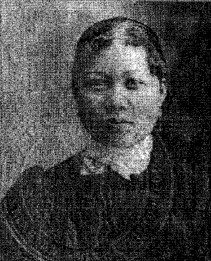In 1899, Ah Sou, a Chinese orphan, was sold to a man named Moy Sam with the belief that she would accompany him to the United States of America to become his daughter. There are no records indicating why or how she was sold. After her trip across the Pacific Ocean, she landed at Port Townsend, Washington, on August 23, 1900, and discovered that she would be forced into prostitution.1 Despite learning this, she followed the orders she was given, and told immigration inspectors at the entry port that Moy Sam was her father and a merchant.

After enduring three years of abuse from Moy Sam, she overheard that she was about to be sold to another man for further exploitation. She decided that she needed to act fast before being sold, and found a way to escape in November of 1903 to The Home for Chinese Women and Girls. Reverend William Holt and his wife, Frances Holt, unintentionally founded the home in Portland, Oregon after serving as American missionaries in China. It began with one Chinese woman who sought refuge with Reverend and Mrs. Holt; not long after, more women followed her lead. Eventually, the home, located at 350 Fourteenth Street, was opened in April 1889.2
There was a Board of Directors of the Home in Portland, which gave it a certain degree of legitimacy. The home taught the women how to speak English, as well as how to read English and Chinese. They were educated in various skills, such as housework, needle-work, and Bible studies. Mrs. Holt said, “They eat Chinese food, wear Chinese clothes, except the shoes, have very plain furniture in their rooms, and are led to look forward to such lives as respectable, intelligent Chinese women may hope to enjoy. The purpose is not to make them over into American women, which might end in dissatisfaction and unhappiness by and by, but we want them to develop into good, useful Chinese women.”3 The home was such a success that a deaf-mute girl, who was raised there, gave a speech at a board meeting, gesturing, “More love to thee.”4

While Ah Sou was at the home, she was the only girl there, which made the days long and boring for her. While she was there, she was married by Reverend Holt to a Chinese man named Lum Kong, because they believed that he was a Chinese merchant. That was important, because being married to a Chinese merchant meant that Ah Sou would be able to legally stay in America. After a number of weeks, Ah Sou made it very clear that she wanted to leave the home, because being the only girl there made her feel very lonely. Frances Holt and the staff did not like the idea of her leaving. Mrs. Holt said, “We wished [Ah Sou] to stay, we did everything we could to persuade her to stay, we hoped she would stay with us for a year or more and it was [Lum Kong’s] wish that she stay, but she said she did not want to, she preferred to leave.”5 Although Lum Kong wanted Ah Sou to stay, he did nothing to keep her from leaving because their marriage did not mean much to him. He knew that the sole reason for their marriage was to try to legalize her status in the United States.
After she left the home, Ah Sou traveled to Seattle where she ran into Moy Sam, who was cooperating with law enforcement to have her arrested. On January 1, 1904, she was arrested by an immigration inspector, and on January 8, 1904, Commissioner James Kiefer ordered her to be deported to China. In between her apprehension and the deportation order, there was a lengthy hearing at which a number of witnesses testified. These witnesses included: the immigration inspectors who arrested and interviewed Ah Sou, a baggageman for the Northern Pacific Railroad who knew Moy Sam, the photographer who helped Moy Sam create a fake family photograph, Mrs. Holt, the employer of Lum Kong, and Lum Kong. When Ah Sou was asked about her time with Moy Sam she said, “I was whipped and beaten by [Moy Sam]. Every day I was beaten by him with sticks of wood until I was black and blue.”6 She also informed the court that she never received any of her earnings during her time with Moy Sam. At the end of the hearing, it was decided that the only reason for Ah Sou’s marriage was so that she would not be deported, thus making her deportable. She was seen as nothing more than an illegal immigrant turned prostitute. However, Ah Sou refused to give up and appealed the deportation order to the United States District Court for the District of Washington, where Judge Cornelius Hanford presided over her appeal.

Although Judge Hanford’s further investigation led him to find out that Lum Kong was not actually a merchant, and he agreed that Ah Sou’s marriage was not bona fide, he still decided to reverse the deportation order. Judge Hanford stated, “The laws excluding Chinese immigrants and women imported for immoral purposes require the court to cause a person in the situation of the appellant to be deported to China. Compliance with the statute in this case will be, in my estimation, a barbarous proceeding, for it will be equivalent to remanding the appellant to perpetual slavery and degradation.”7 He also emphasized Ah Sou’s great effort to escape Moy Sam and create a life for herself. He stressed that the Thirteenth Amendment prohibits slavery and that the only way she could be emancipated was if she was released from custody and allowed to remain in America. Unfortunately, the government appealed Judge Hanford’s decision to the United States Court of Appeals for the Ninth Circuit.
Ah Sou argued that the court did not have any right to her case, and said, “[The] sole question involved is the application of the thirteenth amendment to the Constitution of the United States, and that therefore the appellate jurisdiction of the Supreme Court is exclusive.” However, the Judiciary Act of 1891 gave the Supreme Court exclusive jurisdiction over “the construction or application of the Constitution of the United States.”8 This court ruled, “We see no escape from the conclusion that the judgment of the trial court must be reversed, and the appellee remanded to the country whence she came.”9 Ah Sou tried appealing this ruling to the Supreme Court, but her appeal was denied for lack of jurisdiction. On March 8, 1906 Ah Sou was placed aboard a steamer named “Manchuria,” and left San Francisco for Hong Kong, China. That is where her records end; nothing more was heard of Ah Sou.10
Unfortunately, there are many other stories just like Ah Sou’s, where young girls are sexually exploited and are seen as nothing more than illegal immigrants. More recently, the Trafficking Victims Protection Act of 2000 has been created to help persons trafficked and ensure that traffickers face adequate consequences. This act ensures that governments have recovery centers that provide medical treatments to heal the physical and mental abuse that victims endure. Yet there are still instances like Ah Sou’s that have holes and gaps in their journey that may never be discovered, as sex-trafficking victims are only provided minimal care so that some governments can say that they are doing their job to make sure the victims are accounted for.11
It is not shocking that a Chinese orphan was so easily tricked into being trafficked. Sex trafficking is still a global issue, but is especially prevalent in China. During China’s early years of economic liberalization, sex establishments were operated in the Special Economic Zones. These establishments catered to everyone–clients ranged from local businessmen to foreign investors. The sex-trafficking industry is so common in China, that every major city has a red-light district, which is where sex establishments congregate to make it easier for people to locate them.12 If you or anyone you know is being sex-trafficked or at risk, the National Human Trafficking Hotline is +1 (888) 373-7888. They have translators that speak over 200 language who are available 24/7. If you would like to send them a message, text “HELP” or “INFO” to 233733. For more information please visit https://humantraffickinghotline.org/.13
- Margaret McKeown and Emily Ryo, “The Lost Sanctuary: Examining Sex Trafficking Through the Lens of United States v. Ah Sou,” Cornell International Law Journal 41, no. 3 (2008): 748. ↵
- Margaret McKeown and Emily Ryo, “The Lost Sanctuary: Examining Sex Trafficking Through the Lens of United States v. Ah Sou,” Cornell International Law Journal 41, no. 3 (2008): 749. ↵
- Margaret McKeown and Emily Ryo, “The Lost Sanctuary: Examining Sex Trafficking Through the Lens of United States v. Ah Sou,” Cornell International Law Journal 41, no. 3 (2008): 750. ↵
- David Livingstone, “What Japanese Christian Women are Doing for Korea,” Woman’s Work 48, no. 3 (1913): 165. ↵
- Margaret McKeown and Emily Ryo, “The Lost Sanctuary: Examining Sex Trafficking Through the Lens of United States v. Ah Sou,” Cornell International Law Journal 41, no. 3 (2008): 751. ↵
- Margaret McKeown and Emily Ryo, “The Lost Sanctuary: Examining Sex Trafficking Through the Lens of United States v. Ah Sou,” Cornell International Law Journal 41, no. 3 (2008): 749. ↵
- Margaret McKeown and Emily Ryo, “The Lost Sanctuary: Examining Sex Trafficking Through the Lens of United States v. Ah Sou,” Cornell International Law Journal 41, no. 3 (2008): 753. ↵
- Margaret McKeown and Emily Ryo, “The Lost Sanctuary: Examining Sex Trafficking Through the Lens of United States v. Ah Sou,” Cornell International Law Journal 41, no. 3 (2008): 754-755. ↵
- Margaret McKeown and Emily Ryo, “The Lost Sanctuary: Examining Sex Trafficking Through the Lens of United States v. Ah Sou,” Cornell International Law Journal 41, no. 3 (2008): 755. ↵
- Margaret McKeown and Emily Ryo, “The Lost Sanctuary: Examining Sex Trafficking Through the Lens of United States v. Ah Sou,” Cornell International Law Journal 41, no. 3 (2008): 755. ↵
- “2018 Trafficking in Persons Report” (Department of State, June 2018), 4,39 https://www.state.gov/documents/organization/282798.pdf. ↵
- Bonny Ling, “Human Trafficking and China: Past and Present” (Thesis, National University of Ireland Galway, 2014), http://hdl.handle.net/10379/4730. ↵
- “National Human Trafficking Hotline,” National Human Trafficking Hotline, accessed April 6, 2019, https://humantraffickinghotline.org/node. ↵



55 comments
Ariana Brown
It is appalling that the court could hear of her treatment and do nothing to Moy Sam. His behavior was illegal in so many different ways and, if they chose not to act on that or give her any form of restitution, they should’ve at least granted her stay in light of what she went through. This acts as a good example of what women were thought of and how they were treated and even worse, how immigrants were treated. Sadly, the subjects of sex trafficking, sexism and racism is still prevalent in modern day America but the law would have been forced to act differently.
Azucena Cuevas
It is such disgusting how people have to fear sex trafficking till this day. I cannot imagine what the victims must feel and all the torment they go through. It is horrifying how immigration and all the judges turned their backs on Ah Sou after she told her story. All that rung in their head was that she was an immigrant, instead of protecting her from her abuser. This article was great because it really brings to light how the american court turns away from such a huge issue.
Paul Garza
I love that this article is talking about something that unfortunately still prevails today. So sad that ah sou was taken advantage of, honestly I am not shocked that the United States government didn’t give her the justice she deserved. Even today our government and society seems to work against sexual assault victims. This article was very well written to carefully tell the story of ah sou and show a bigger picture that sex trafficking stretches across the globe.
Kimberly Parker
It’s so shocking knowing the actual length of sex trafficking, and what people sold into it have to endure. Not only are they sold usually at a young age, but then around that same age, they lose all of their innocence due to greedy men that only want money. They have to endure all of that emotional and physical trauma, while also trying to find the will to survive. When reading what AH Soh had to go through, and how the American court just ended up deporting her back to her own country, basically sealing her fate, it made me realize just how unfair the world really is. This article was very eye-opening to the topic of sex trafficking and what usually happens to their victims, and how people’s lives get affected by it, whether they’re the victim, or they know the victim.
Amanda Quiroz
It’s so sad and scary how a child can be so easily lead into human trafficking like that. It’s hard to read that Ah Soh got deported back to China. It’s just so unfair that it happened to her. This article was very eye opening towards what can happen and how it can so easily impact one’s life in such a way.
Kathryn Martinez
Ah Shou was tricked into trafficking as a child during the time there weren’t phones in our hands that can get us information within a second. It’s terrifying to think how much we’ve progressed and how much the trafficking rings have progressed. As we become more advanced in technology, the more deep web actions can occur and the amount of backdoor stepping can occur as well. It’s a horrible thing to realize that humans have become much smarter but at the same time more wicked.
Charli Delmonico
The content of this article was truly very difficult to read. I had figured that Ah Sou’s story would end with the government siding with her and her captor being taken to prison where he belonged; I most definitely was not expecting the story to end with Ah Sou being deported and never being heard of again. Sex trafficking is a major problem in today’s society which is both terrifying and sad. Ah Sou had such a rough life, and she didn’t deserve the physical and mental abuse that she endured at the hands of her evil captor. It is so difficult for women to have to endure this kind of trauma, but there hasn’t been a world-changing solution to this issue yet, so our only goal can be to find a way to stop these incidents from happening and perhaps implementing a global plan that somehow eradicates this problem. The only issue with that is that getting rid of this issue would be as difficult as ending world hunger. It is worth trying to stop, but stopping it everywhere almost seems like an unattainable goal.
Maria Garcia
Sex trafficking is something that seems to be progressing more and more as time goes on, and it’s absolutely sickening because it can happen to anyone at any age. This article was very well written and clearly researched greatly. Ah Shou experienced so many terrible things due to the trafficking. It’s saddening that she got sent back to China because no one is aware or acknowledges the dangers she could face going back there as well.
Paola Arellano
Unfortunately enough, deportation is something that still occurs today. The story of Ah Shou Saddens me as sex trafficking is a never ending cycle. What happened to her can happen to many and saddens me as sex trafficking is a never ending cycle. What happened to her can happen to many and still does. No other opportunity was given to her even when opportunity is all that she seen it. I think that the author did a wonderful job of portraying the story to the best of her abilities and I am sure that the characters up with even think her for telling her story.
Maria Martinez
The story of Ah Sho really goes to show how unfair the american government has been in history and sometimes still is today. There are so many stories such as Ah Sho’s and so many that are currently happening, this article does a really good job at calling for action from society and the government to do more for the many victims of trafficking. This is a very tough topic to write and read about but it is so important that people stay informed of the terrible realities that so many innocent men, women and children face, especially immigrants.